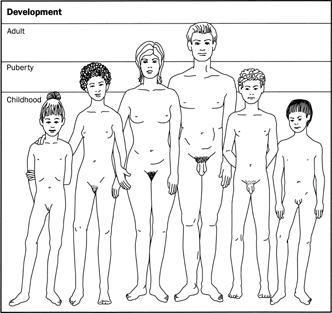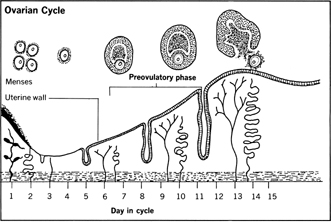Puberty and Growth - Puberty: changes in girls
The physical changes that occur in the female body during puberty probably are more dramatic than those associated with a boy progressing into manhood. One definite milestone for the girl is her first menstruation , commonly regarded as the first sign of puberty. Actually, the first menstruation, known as the menarche , is only one of several signs of puberty, along with the slimming of the waist, gradual broadening of the hips, the development of breasts, the appearance of hair about the genitals and in the armpits, and a change in the rate of growth.
The Menarche
The age at which a girl first experiences menstruation generally varies over a period of ten years and depends upon the structural development of the youngster, her physical condition, the environment, and hereditary factors. Menarche can occur as early as the age of 7, and most physicians would not be overly concerned if a girl did not begin to menstruate until she was approaching 17. The age range of 9 to 16 usually is considered normal. The median age for the start of menstruation is around 13½ years, which means that 50 percent of all females are younger than 13 years and 6 months when they reach the menarche, and half are on the older side of that age when they first menstruate. In general, the pubertal experiences of a girl follow a pattern like that of her mother and sisters; if the mother began menstruating at an early age, the chances are that her daughters will also.
If the girl has not reached the menarche by the age of 18, she should be examined by a gynecologist , a physician who specializes in problems related to the female reproductive system. A medical examination also should be arranged for any girl who experiences menstruation before she reaches the age of eight or nine years.
When menarche occurs on the early side of childhood, the condition is sometimes called precocious puberty . The child may suddenly begin menstruating before her mother has told her what to expect, a situation that can prove embarrassing to both child and parents. It may first be detected by a teacher at school; occasionally, a young girl may be aware of bleeding from the vagina but because of fear or false modesty does not report the event to her mother or teacher. For this reason, parents should be alert for changes associated with early puberty and be prepared to explain the facts of life to their children. Also, in the case of precocious puberty, parents should arrange for medical consultation to be certain the bleeding actually is the result of first menstruation and not the effects of an injury or tumor.

Growth Spurt before Menarche
During the year or two preceding the menarche there is a growth spurt of two or three inches. This is because of the hormone changes of puberty. The hormones are chemical messengers secreted by glands in various parts of the body and carried rapidly through the bloodstream to organs or other glands where they trigger reactions. The spurt in growth preceding menarche results from the secretion of a growth hormone that is produced by the pituitary gland, and androgen, a hormone secreted by the adrenal glands. They produce rapid growth of the bones and muscles during puberty. The girl who is first among her classmates to menstruate often is larger than those who are of the same age but have not yet reached the menarche.
From numerous research studies of the menarche, it has been learned that poor nutrition and psychological stress sometimes delay the onset of menstruation, that girls reared in cities tend to menstruate earlier, and that climate is a factor, although both tropical and arctic climates seem to be related to early menarche. The first menstrual periods also are likely to occur during the school year, September to June, rather than during the summer vacation.
The First Menstrual Cycles
The first menstrual cycles tend to be very irregular and have been known to be as short as 7 days and as long as 37 weeks. Even when regularity becomes established, the adolescent menstrual cycle usually is longer than the average for adult women. The typical menstrual cycle of a young girl may be about 33 days, compared to an average of 28 days for an adult woman. About three years elapse before the menstrual cycles become regular. In the meantime, irregular menstrual patterns can be considered as normal for girls during puberty.
The first menstrual cycles also are anovulatory . In other words, the young girl's ovaries have not matured sufficiently to produce an ovum , or egg cell, that can be fertilized by the sperm of a male. There are, of course, the exceptions that make newspaper headlines when a little girl gives birth to a baby. But anovulatory menstruation generally is the rule for the first few months after the menarche.
Delayed Puberty
Delayed puberty probably causes as much anguish as precocious puberty. The last girl in a group of childhood chums to develop breasts and experience the menarche may feel more self-conscious than the first girl in the class to menstruate. If the signs that usually precede menarche have not appeared by the age of 17 or 18, a medical examination should be considered, even though the girl may be a late-late-bloomer at the other end of the spectrum from the 7- or 8-year-old child who has menstruated.
The absence of menstruation after a girl is 18 can be the result of a wide variety of factors. The cause sometimes can be as simple as an imperforate hymen , a membrane that blocks the opening of the vagina. It can be the result of a congenital malformation of the reproductive organs, such as imperfect development of the ovaries. Accidents, exposure to carbon monoxide gas, or diseases like rheumatic fever or encephalitis in earlier years can result in brain damage that would inhibit the start of menstruation. The relationship between emotional upset and delayed menarche was vividly demonstrated during World War II when some girls who suffered psychological traumas also experienced very late signs of puberty.
Preparing Your Daughter for Menstruation
A mother's main responsibility is to convince her daughter at the beginning of puberty that menstruation is a perfectly normal body function. The mother should explain the proper use of sanitary napkins or tampons and encourage her daughter to keep records of her menstrual periods on a calendar.
The mother also should explain that menstruation usually is not a valid reason to stay in bed or avoid school or work. The girl should be advised that bathing and swimming should not be postponed because of menstruation. There are many old wives’ tales about menstruation that are not true. But there may be some truth to stories that loss of menstrual blood can be weakening, particularly if the girl's diet does not replace the body stores of iron which may be lowered during menstrual flow. Iron is a key element of the red blood cell, and if iron-rich foods are not included in the meals of women during their years of menstruation they can eventually suffer a form of iron-deficiency anemia.

Hormone Activity: Becoming a Woman
Although the sex hormones are the key to what makes girls grow into women and boys into men, both sexes appear to receive secretions of male and female sex hormones in approximately equal amounts for about the first ten years of life. But as puberty approaches, the adrenal glands of girls seem to increase production of a female sex hormone, estrogen . Meanwhile, a nerve center in the hypothalamus area of the brain stimulates the pituitary gland, the master gland of the body, to secrete another kind of hormone, gonadotropik . Gonadotropin in turn activates a follicle-stimulating hormone that causes a maturation of the ovaries, which are part of the original equipment girls are born with but which remain dormant until the start of puberty.
During the second decade of life, the hormone activity stimulates the development of body tissues that not only grow in size but give a girl more womanly contours. However, the fully mature contours of a woman usually do not appear until after the ovaries are functioning and still another female sex hormone, progesterone , has been introduced in the system. The ovaries, uterus, Fallopian tubes, and vagina gradually mature as the menarche draws near.

Comment about this article, ask questions, or add new information about this topic: